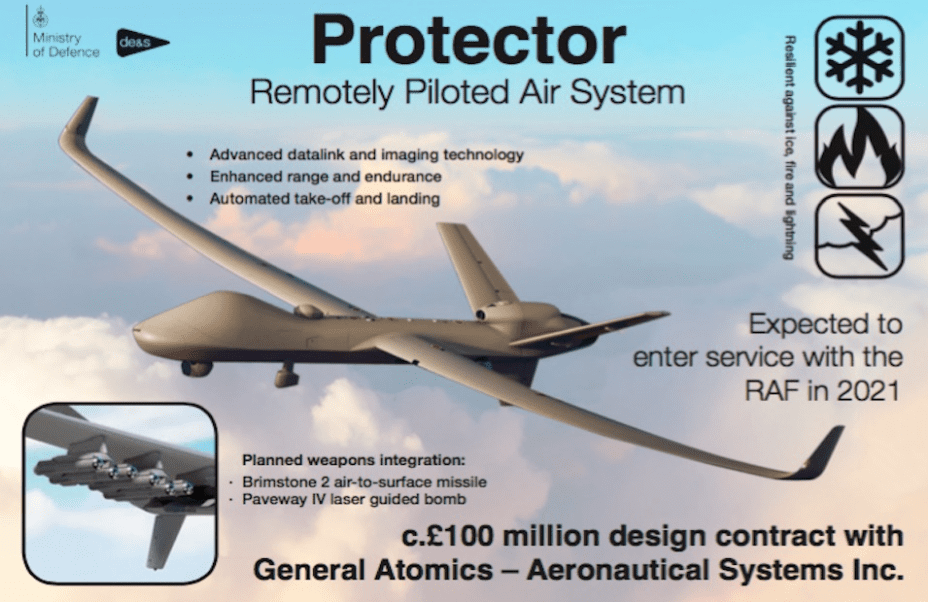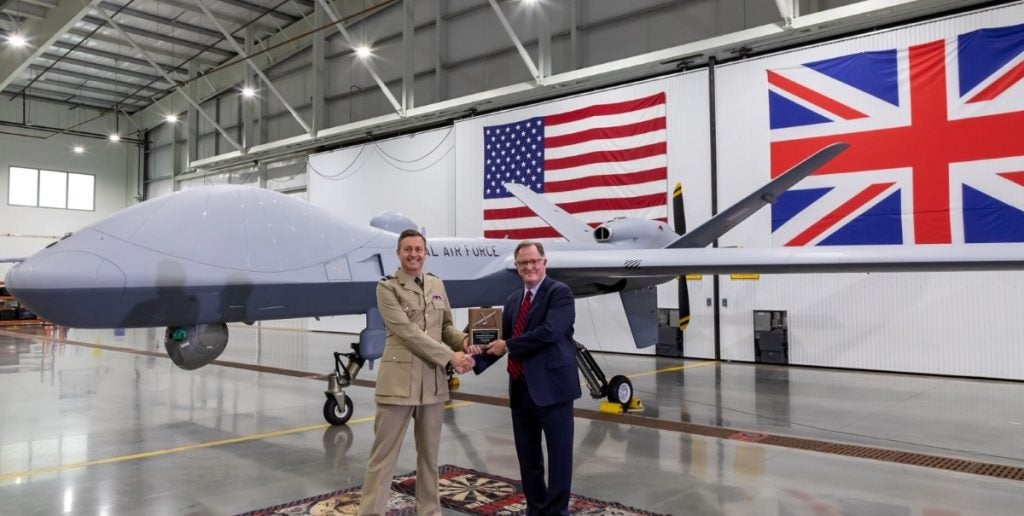RAF Protector Passes Final Tests
Last week, General Atomics Aeronautical Systems, Inc. announced that the first Royal Air Force Protector RG Mk1 had completed Acceptance Test Procedures (ATP) on 26 August, allowing the aircraft to be officially handed off to the Royal Air Force. The first Protector, N469SG, flew for just under two hours on 26 August in a joint flight with UK Ministry of Defense and General Atomics personnel. The Acceptance Test Procedures consist of “all inspections and tests performed on the hardware in operation for the aircraft and in conformance with the functional specification and technical requirements”, the General Atomics press release stated. In addition to the aircraft, testing was completed on ground support equipment known as “Portable Pre-flight and Post-flight Equipment”, or P3Es.
The Protector program, formerly known as Project Scavenger, began in its current iteration in October 2015. The initial hope with Scavenger was to find a completely new replacement for the RAF’s current fleet of MQ-9A Reapers. At the Farnborough Air Show in July 2010, General Atomics stated that their Predator C Avenger aircraft was a “significant candidate” for Scavenger. By the time Scavenger was converted to Protector, the UK MOD had yet to publicly announce the selection of an aircraft for the program. At the Farnborough Air Show in July 2016, General Atomics announced that the UK MOD had selected the “Certifiable Predator B”, or CPB, for the Protector program. In December of that same year, the UK MOD announced the initial £100 million contract for General Atomics to develop the Protector from CBP.

The Certifiable Predator B, a variant of the MQ-9A Block 5, is designated as MQ-9B. This variant carries important new hardware developed specifically for use of the MQ-9 in non-segregated civilian airspace, including equipment called the “Detect and Avoid System” (DAS) by General Atomics. The DAS senses nearby aircraft using radar and transponder hardware and allows the pilot to avoid civilian traffic. Developments that GA-ASI designed for Protector have gone into the MQ-9B SkyGuardian, which is destined for customers like the Japanese Coast Guard, Belgian Air Force, and Taiwanese Air Force. The MQ-9B Protector can be armed with MBDA Brimstone missiles and Raytheon UK Paveway IV laser-guided bombs, whereas the standard version of the MQ-9B SkyGuardian cannot; a specific upgrade package (known as the “Weaponized Version”) is required to support live munitions.

The Protector MQ-9s were initially planned to enter service with the RAF in 2021, according to the MOD. Freedom of Information Act documents released to Drone Wars UK indicated that, in January 2016, “GA-ASI needed better to understand the UK requirements and intent for operating PROTECTOR, and the associated constraints in the UK”. Because of this, in 2018 the RAF adjusted the anticipated arrival date to a less-specific “early 2020s”. At the Farnborough Air Show in July 2018, the RAF showed off the General Atomics Protector demonstrator aircraft – which bore the American registration N190TC – after it completed an over 24 hour long flight from Grand Forks Air Force Base in Grand Forks, North Dakota to RAF Fairford near Fairford, UK.

In September 2019, the UK MOD announced an additional £100 million contract needed to continue development of the Protector, and a new delivery date: 2024. An additional £65 million GBP was allocated for Protector the next year, needed to build the first three aircraft. In July 2021, the UK MOD ordered an additional 13 Protectors at a total cost of £195 million, noting that the first three were complete and undergoing test and evaluation in the US. This announcement moved the delivery date up a year, to 2023. Now, with the completion of this major milestone in the Protector program and after over £450 million GBP of costs and contracts, N469SG will remain in the US to support maintenance and pilot training until the aircraft is delivered to RAF Waddington in 2023.
The RAF see Protector as a step change in capability. When the aircraft begins operations in 2024 it will provide significantly improved endurance and provide a very capable armed Intelligence Surveillance, Targeting and Reconnaissance (ISTAR) platform.

